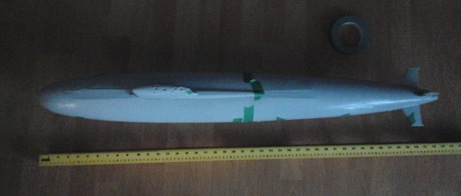Here are some views of Moebius’ 1/72 scale USS Skipjack held together with green painter’s tape.
Skipjack was the first nuclear-powered hunter killer submarine using the teardrop hull design that optimised underwater performance. Skipjack and her sisters were the fastest submarines in the US Navy until the arrival of the Los Angeles class boats in the 1970s. They remained in front line service until they were decommissioned in 1990.
The navy rushed its first two ballistic missile submarines to sea by modifying the Skipjacks and redirecting some of the parts to what became the George Washington class. A cut in the hull, the addition of about an extra 130 feet, 16 missile tubes and some other structural changes and the Americans had a working launch platform. Unfortunately, they could be as noisy as hell.
Ambitious modellers could convert this kit to a George Washington. The easier conversion would be to build a GW after its conversion from a missile carrying submarine. The navy chopped out the missile sections and stuck the bow and stern back together. The end results as a Skipjack with the old fairing around the sail that led up to top of the missile section left in place.
The picture quality isn’t great but for those interested in these things, it will give a sense of the size of this kit.
The front of the box says the kit builds to 40 inches. The back of the box says 42 inches. The back is right. That’s a 48 inch level in the foreground and while you can’t see it clearly in this picture, the submarine will be 42 inches almost exactly from the tip of the bow to the point at the end of the five-bladed screw.
Here’s another view from the top:
The hull is split into four sections fore, aft, top, and bottom. The sections are bagged and wrapped in soft plastic to prevent scratches and dings in shipping. The entire kit is packed into a box 22 inches long. This facilitates shipping and helps to keep the costs down.
The surface detail is finely molded with slightly recessed lines. There is a waterline molded into the upper hull. This mars the finish toward the bow where it cross the upper sonar array but you can fix that with a skillful application of some putty. Fore and aft of the sail, you will find all the hatches marked, included the main access hatches as well as the ones covering the mooring cleats and bollards.
On the sail, most of the batches appear to be outlined, including the two main hatches that open onto the dive planes. These were used when in port as easy access to docks, as well as for observation and mounting armed watches (guards). None of the hatches are open so if anyone wants to do so, they’ll have to scratch build the interiors behind them.
The kit includes markings for all Skipjack-class submarines, including Scorpion.
Out of the box, the kit builds as a submarine in its launch configuration and paintjob. The two buoy hatches on the topsides are to be painted international orange. That isn’t correct for an operational submarine. you’ll have to do some research to decide how you want to paint your submarine. If you hunt around, you can find some very useful advice on weathering, especially for the anti-fouling red on the lower half of the hull.
The screw is the original five-bladed design. The Skipjacks received seven bladed screws during refits in the early to mid- 1970s in order to correct a noise problem. No biggie. If you build Skipjack from the box and change the paint scheme, you will get an historic ship from the time she sailed into Murmansk harbour and reputedly sat submerged a mere 30 or 40 metres off the end of a busy pier and watched goings-on in one of the old Soviet Union’s major naval bases.
-srbp-

